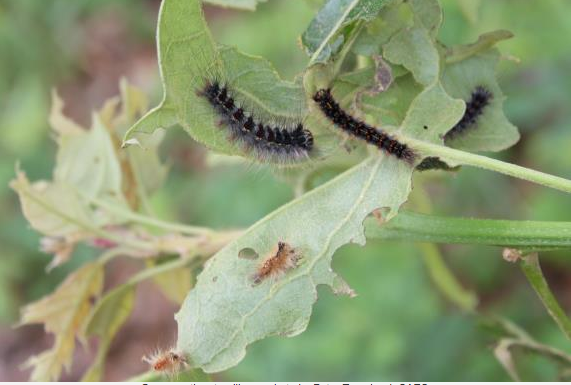
The potential for gypsy moth outbreak exists every year in our community.
Dr. Kirby Stafford III, head of the Department of Entomology at the Connecticut Agricultural Experiment Station, has written a fact sheet on the gypsy moth available on the CAES website. The following information is from this fact sheet.
The gypsy moth, Lymantria dispar, was introduced into the US (Massachusetts) by Etienne Leopold Trouvelot in about 1860. The escaped larvae led to small outbreaks in the area in 1882, increasing rapidly. It was first detected in Connecticut in 1905. By 1952, it had spread to 169 towns. In 1981, 1.5 million acres were defoliated in Connecticut. During the outbreak of 1989, CAES scientists discovered that an entomopathogenic fungus, Entomophaga maimaiga, was killing the caterpillars. Since then the fungus has been the most important agent suppressing gypsy moth activity.
The fungus, however, cannot prevent all outbreaks and hotspots have been reported in some areas, in 2005-06 and again in 2015.
The life cycle of the gypsy moth is one generation a year. Caterpillars hatch from buff-colored egg masses in late April to early May. An egg mass may contain 100 to more than 1000 eggs and are laid in several layers. The caterpillars (larvae) hatch a few days later and ascend the host trees and begin to feed on new leaves. The young caterpillars, buff to black-colored, lay down silk safety lines as they crawl and, as they drop from branches on these threads, they may be picked up on the wind and spread.
There are four or five larval stages (instars) each lasting 4-10 days. Instars 1-3 remain in the trees. The fourth instar caterpillars, with distinctive double rows of blue and red spots, crawl up and down the tree trunks feeding mainly at night. They seek cool, shaded protective sites during the day, often on the ground. If the outbreak is dense, caterpillars may feed continuously and crawl at any time.
With the feeding completed late June to early July, caterpillars seek a protected place to pupate and transform into a moth in about 10-14 days. Male moths are brown and fly. Female moths are white and cannot fly despite having wings. They do not feed and live for only 6-10 days. After mating, the female will lay a single egg mass and die. The egg masses can be laid anywhere: trees, fence posts, brick/rock walls, outdoor furniture, cars, recreational vehicles, firewood. The egg masses are hard. The eggs will survive the winter and larvae hatch the following spring during late April through early May.
The impact of the gypsy moth can be extensive since the caterpillar will feed on a wide diversity of trees and shrubs. Oak trees are their preferred food. Other favored tree species include apple, birch, poplar and willow. If the infestation is heavy, they will also attack certain conifers and other less favored species. The feeding causes extensive defoliation.
Healthy trees can generally withstand one or two partial to one complete defoliation. Trees will regrow leaves before the end of the summer. Nonetheless, there can be die-back of branches. Older trees may become more vulnerable to stress after defoliation. Weakened trees can also be attacked by other organisms or lack energy reserves for winter dormancy and growth during the following spring. Three years of heavy defoliation may result in high oak mortality.
The gypsy moth caterpillars drop leaf fragments and frass (droppings) while feeding creating a mess for decks, patios, outdoor furniture, cars and driveways. Crawling caterpillars can be a nuisance and their hairs irritating. The egg masses can be transported by vehicles to areas where the moth is not yet established. Under state quarantine laws, the CAES inspects certain plant shipments destined to areas free of the gypsy moth, particularly for egg masses.
There are several ways to manage the gypsy moth: biological, physical and chemical.
Biologically, the major gypsy moth control agent has been the fungus E. maimaiga. This fungus can provide complete control of the gypsy moth but is dependent on early season moisture from rains in May and June to achieve effective infection rates and propagation of the fungus to other caterpillars. The dry spring of 2015 resulted in little or no apparent fungal inoculation or spread until it killed late-stage caterpillars in some areas of the state, after most defoliation.
Infected caterpillars hang vertically from the tree trunk, head down. Some die in an upside down “V” position, a characteristic of caterpillars killed by the less common gypsy moth nucleopolyhedrosis virus (NPV). This was not detected in caterpillars examined in 2015.
Physical controls include removing and destroying egg masses, which can be drowned in a soapy water and disposed of. Another method is to use burlap refuge/barrier bands wrapped around tree trunks so that migrating caterpillars will crawl into or under the folded burlap or be trapped by the sticky band.
There are a number of crop protection chemicals labeled for the control of gypsy moth on ornamental trees and shrubs. There are treatments for egg masses, larvae and adult moths. Detailed information about these chemical treatments is available in the CAES factsheet.
For complete information about the gypsy moth and its management, visit the CAES website and look for the fact sheet on gypsy moth.